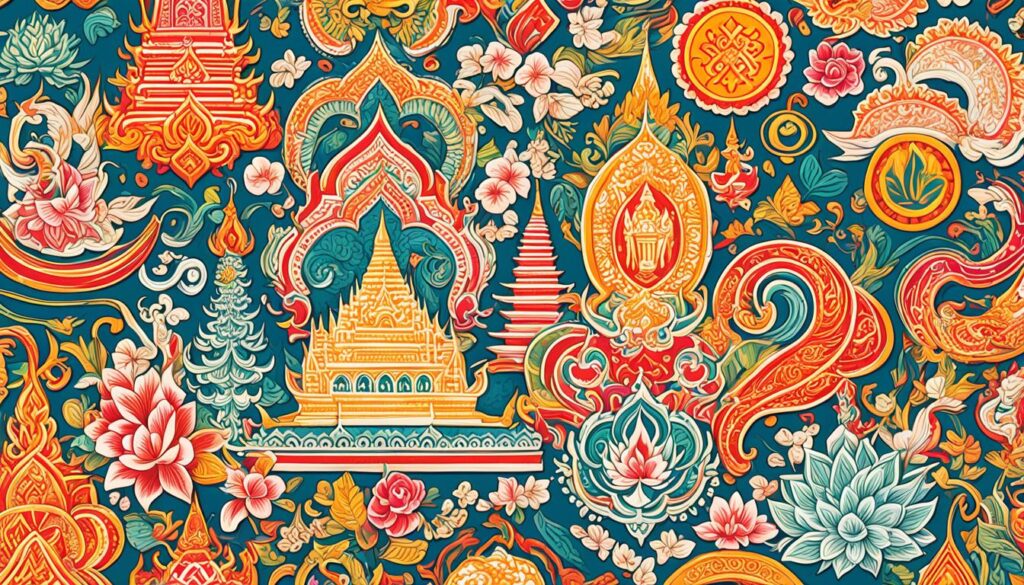Did you know that the Pa’O Language, also known as the Pa’O dialect, is a Sino-Tibetan language spoken in Thailand and Myanmar? This unique language is primarily spoken by the Pa’O people, an ethnic group indigenous to Myanmar. It holds great importance in the linguistic landscape of Southeast Asia.
The Pa’O Language is mainly found in the Shan State of Myanmar, but it is also spoken in other states such as Kayah State, Kayin State, and Mon State. As part of the Karenic subgroup of the Sino-Tibetan language family, it belongs to the larger Mon-Khmer language group, which includes other Southeast Asian languages.
With its rich historical and cultural significance, the Pa’O Language stands as an indigenous language of Myanmar. Join us as we delve deeper into the fascinating world of the Pa’O Language and the unique heritage of the Pa’O people in Thailand.
The Pa’O People and their Language
The Pa’O people are a unique and distinct ethnic group found in both Thailand and Myanmar. While linguists consider them a subgroup of the Karen people due to similarities in their language, the Pa’O people themselves identify as a separate and unique group. In Thailand, they are also known as Tongsu or Toongsoo.
According to Ethnologue, there are approximately 858,740 Pa’O people living in Shan State, Myanmar. However, other sources suggest that the actual population may be much higher, ranging from 1,800,000 to 2,000,000 people, making them the second largest ethnic group in Shan State.
The Pa’O people have two main dialects: the Southern Pa’O dialect spoken by those living in the Thaton area of Mon State, and the Northern Pa’O dialect spoken by those in and around Taunggyi, the capital of Shan State. Despite these dialect differences, speakers of both dialects are generally able to understand each other.
Additionally, the Pa’O people are further divided into at least 24 subgroups, each with their own unique cultural practices and traditions. This adds to the rich diversity within the Pa’O community.
Pa’O People Statistics
| Location | Population |
|---|---|
| Shan State, Myanmar | Approximately 858,740 |
| Other regions of Myanmar | 1,800,000 to 2,000,000 (estimated) |
The Pa’O Language in Thailand
While the exact number of Pa’O people living in Thailand is unclear, there are definitely Pa’O communities in certain regions.
In Chiang Mai, there is a Pa’O presence, with the Wat Nong Kham in Chiang Moi Street serving as a Pa’O temple. The Pa’O people in Chiang Mai participate in events such as the Songkran Festival and maintain their traditional dress and cultural practices.
In Mae Hong Son Province, there are also several Pa’O villages. Research is currently being conducted to learn more about these communities and their language.
| City | Province | Villages |
|---|---|---|
| Chiang Mai | Chiang Mai | Wat Nong Kham, Chiang Moi Street |
| Mae Hong Son | Mae Hong Son Province | Several Pa’O villages |
Pa’O Language and the Kakku Pagodas
The Kakku Pagodas, located in Myanmar, hold deep significance for the Pa’O people. This archaeological site is believed to date back to the 3rd century BC and is a visually stunning testament to ancient craftsmanship. With over 2,000 stupas clustered together, the Kakku Pagodas offer a breathtaking sight that attracts visitors from around the world.

When exploring the Kakku Pagodas, visitors are required to register at the office in Taunggyi. To enhance their experience and gain deeper insights, it is recommended to have a knowledgeable guide from the Pa’O people accompany them. These Pa’O guides bring the site to life with their expertise, sharing the historical and cultural significance of the pagodas.
| Pa’O Language and the Kakku Pagodas | |
|---|---|
| Archaeological Site | Kakku Pagodas |
| Main Attraction | Over 2,000 stupas dating back to the 3rd century BC |
| Guided Experience | Pa’O guides provide valuable insights and knowledge about the pagodas |
Pa’O Presence in Chiang Kham
Chiang Kham, a district in Phayao province, is known for its significant Pa’O presence. One notable landmark is the Wat Nantaram, a Pa’O temple that showcases unique architecture, setting it apart from other temples in the area.
Sponsored by Takachongnanta Wonganon, a Pa-O man who relocated from Taunggyi in Southern Shan State, Myanmar, the temple holds historical and cultural significance. Wonganon played a crucial role in establishing the temple and hired a Burmese foreman to oversee its construction. Built in the early 20th century, the Wat Nantaram is known for its teak wood Buddha image hall, which exemplifies the distinct architectural style of the Pa’O people.
Historical Significance of Wat Nantaram
The Wat Nantaram in Chiang Kham stands as a testament to the rich cultural heritage and architectural prowess of the Pa’O people. Its unique design and intricately crafted teak wood Buddha image hall make it a must-visit site for tourists and locals alike.
Visitors to Chiang Kham can immerse themselves in the rich Pa’O culture and heritage by exploring the Wat Nantaram. The temple offers a glimpse into the traditions, beliefs, and artistic expressions of the Pa’O people, showcasing the endurance and preservation of their unique cultural identity.
| Features of Wat Nantaram | Description |
|---|---|
| Distinct Architecture | The temple’s unique architecture sets it apart from other temples in the area, showcasing the Pa’O people’s artistic expertise. |
| Teak Wood Buddha Image Hall | The teak wood Buddha image hall is a marvel of craftsmanship, representing the significant artistic contributions of the Pa’O people. |
| Historical Significance | Wat Nantaram dates back to the early 20th century, standing as a historical landmark that reflects the cultural heritage of the Pa’O people. |
The presence of the Pa’O people and their unique temple in Chiang Kham adds to the cultural richness and diversity of Phayao province. Exploring the temple and engaging with the local community provides an opportunity to appreciate the intricate architectural styles and immerse oneself in the vibrant culture of the Pa’O people.
The Linguistic Landscape of Thailand
Thailand is a linguistically diverse country, with a rich linguistic landscape. The official language is Central Thai, also known as Siamese, and it is spoken by the majority of people in Central, Southwestern, and Eastern Thailand. Other languages spoken in Thailand include Isan, a variant of Lao spoken in the northeast, Northern Thai, a Tai-Kadai language spoken in the northern provinces, and Southern Thai, another Tai-Kadai language spoken in the south. Thailand is also home to various minority languages such as Khmer, Malay, Karen, and many more. Thai Sign Language is also recognized in the country, with its development influenced by American Sign Language.

Language Diversity in Thailand
- Central Thai: The official language spoken by the majority of people in Central, Southwestern, and Eastern Thailand.
- Isan: A variant of Lao spoken in the northeast of Thailand.
- Northern Thai: A Tai-Kadai language spoken in the northern provinces of Thailand.
- Southern Thai: Another Tai-Kadai language spoken in the southern regions of Thailand.
Thailand is also home to a wide range of minority languages that reflect the country’s cultural diversity. These include Khmer, spoken by the Khmer minority in Eastern Thailand, Malay, spoken by the Malay-Muslim communities in the southern border provinces, and Karen, spoken by the Karen minority in Northern Thailand. Additionally, there are many more indigenous minority languages spoken by smaller communities throughout the country.
Thai Sign Language
“Thai Sign Language, recognized in Thailand, has its roots in American Sign Language and plays a crucial role in facilitating communication for the deaf community. It has its own grammar and vocabulary, enabling the deaf community to communicate effectively in Thai society.”
The linguistic landscape of Thailand is a testament to the country’s cultural richness and diversity. With various languages spoken and recognized, Thailand embraces its linguistic heritage, allowing different communities to communicate and preserve their unique identities.
Conclusion
The Pa’O Language is a linguistic treasure that holds significant importance in Thailand’s diverse cultural heritage. As one of the indigenous languages in Southeast Asia, it serves as a testament to the linguistic diversity of the region. The Pa’O people, with their rich cultural traditions and history, greatly contribute to the preservation and continuation of the Pa’O Language.
Preserving languages like Pa’O is crucial for maintaining cultural diversity and ensuring the survival of unique linguistic expressions. By celebrating languages such as Pa’O, we not only honor the cultural heritage of the community but also foster a deeper understanding of the world’s linguistic tapestry.
Thailand’s linguistic diversity is a reflection of its vibrant society. While the Thai language remains the primary language, the existence of minority languages, including Pa’O, adds depth and richness to the tapestry of languages spoken in the country. Recognizing and valuing this linguistic diversity enhances our appreciation for the cultural mosaic that Thailand represents.
As we continue to explore and embrace different languages and cultures, the Pa’O Language stands as an important symbol of Thailand’s commitment to linguistic preservation and cultural heritage. By promoting the understanding and preservation of the Pa’O Language, we contribute to the overall celebration of linguistic diversity and the appreciation of cultural expressions.
